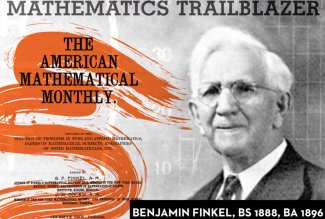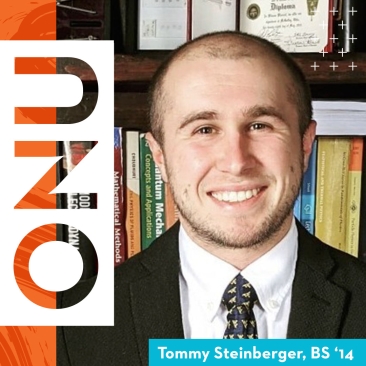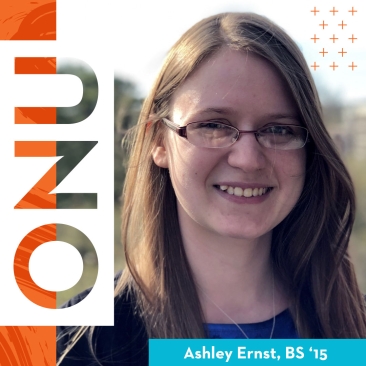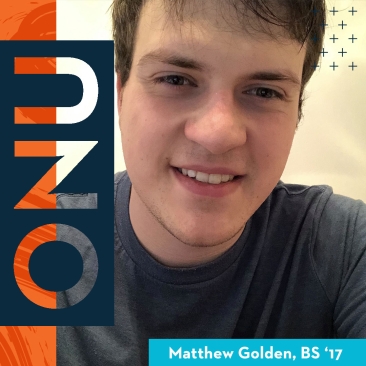"Three’s a crowd: an exploration of subprime tribonacci sequences" - College Mathematics Journal 54, No. 5, 464-475 (2023) - by Sara Barrows, Emily Noye, Sarah Uttormark, and Matthew Wright.
"Three’s a crowd: an exploration of subprime tribonacci sequences" - College Mathematics Journal 54, No. 5, 464-475 (2023) - by Sara Barrows, Emily Noye, Sarah Uttormark, and Matthew Wright.
A wonderful article by Laurie Wurth-Pressel (source)

2024 marks the 130th anniversary of The American Mathematical Monthly.
The trailblazer who launched this premier academic journal in 1894 and inspired the establishment of the American Mathematical Association (AMA) graduated from Ohio Northern University in the late 1800s—Benjamin Franklin Finkel, BS 1888, BA 1896.
Mathematical problems fascinated Finkel from a young age, and his eagerness to solve them impelled his ambition to “publish a journal devoted solely to mathematics and suitable to the needs of teachers of mathematics.”
He once stated: “Many dormant minds have been aroused into activity through the mastery of a single problem.”
Over a century later, Finkel’s statement still rings true.
While much has changed at Ohio Northern since Finkel’s days, the University continues to attract brilliant problem-solvers molded in Finkel’s character who graduate to become leading mathematicians and physicists.
Read about three outstanding alumni from ONU’s School of Science, Technology, and Mathematics, housed in the Getty College of Arts & Sciences, who are making a mark in the world of physics and mathematics.
 From algebra to plasma physics
From algebra to plasma physicsThomas (Tommy) Steinberger, BS ’14, Ph.D., is breaking new ground in experimental plasma physics at West Virginia University in Morgantown, W.V.
A research assistant professor in the Department of Physics and Astronomy, he explores charged gas systems (plasmas), investigating gas particle motion and temperature. His work aims to enhance electronics manufacturing, space travel, and our understanding of space phenomena, such as magnetic reconnection.
“I come into the lab and can work on 10 different projects before lunch,” he said. “I have a lot of ongoing projects that are unique. Most of my effort is helping all these projects move forward.”
Steinberger’s journey began in freshman Algebra class in high school. While his classmates bellyached about having to solve 50 of the 100 algebra problems listed in the final exam, he felt a burst of excitement.
“I completed nearly all 100 in a couple of days, almost obsessively,” he recalled.
His ONU experience further ignited his passion for problem solving. He joined ONU-SOLVE, a problem-solving group of students that tackle the challenging problems found in leading math magazines such as Fibonacci Quarterly, Mathematics Magazine, The College Mathematics Journal, and Finkel’s own The American Mathematical Monthly.
ONU-SOLVE has been recognized multiple times in recent years for submitting correct solutions, and several have been published in leading journals as the most well-written solutions, according to Mihai Caragiu, Ph.D., professor of mathematics.
According to Steinberger, several solutions he worked on with the assistance of ONU professors received honorable mentions in academic magazines.
“My time at ONU really fostered my interest in math and its application to other fields,” he said. “I received fantastic instruction from professors who truly cared about their students.”
After graduating from ONU with a double major in mathematics and physics, and minor in astronomy, Steinberger received a master’s degree in physics and astronomy, and a Ph.D. in experimental plasma physics from West Virginia University.
“The challenge of the subjects (math and physics) resonates with my stubborn nature,” he added. “It leads me to be ever more persistent in my studies.”
 From jigsaw mastery to national defense
From jigsaw mastery to national defenseAshley Ernst, BS ’15, Ph.D., is a senior physicist at Arcfield in Colorado Springs, Colo, where she helps to solve complex challenges in support of the United States’ most critical national security missions.
Arcfield is a leading provider of mission-focused systems engineering and integration capabilities to the U.S. Intelligence Community, Department of Defense, and other agencies.
Ernst is currently working primarily with simulation and modeling of radiation in both vacuum and in atmosphere or material. She develops technical documentation, presents work to clients, and performs calculations with the aid of software.
“There is always another problem on the horizon,” she says. “The quest for the solution to the next problem is what drives me every day.”
Growing up, Ernst loved to solve jigsaw puzzles with her mom. As her skill increased, so did her hunger for harder challenges.
“They became larger in puzzle number, smaller in puzzle piece size, and more complex in shape and design,” she said. “When that wasn’t enough, I started solving puzzles without guide pictures.”
When she first arrived at ONU, however, she lacked focus and felt extremely homesick. Her ONU professors noticed her struggles and made special efforts to engage her in math conferences and ONU-SOLVE. Professor Caragiu spurred her mind into action by exposing her to Graph Theory and Discrete mathematics.
“Having a direction for my mental energy definitely helped me,” she said.
Within a short time, she says, she was on a better path forward. “I would not be where I am today without their help. The math and physics programs at ONU nurture the search for knowledge. No matter the level, the program meets the student at that level and pushes them to the next level.”
After graduating from ONU with a double major in physics and applied mathematics, Ernst earned a master’s degree in physics and a Ph.D. in hadronic physics from Florida State University. Her second year of graduate school, she received a highly-competitive National Science Foundation (NSF) Graduate Research Fellowship, which she credits to the quality of education and one-on-one mentoring she received at ONU.
“Each student that passes through the math program at ONU is instilled with a sense of excitement regarding a problem. While that problem may change, that excitement stays,” she said.
 From twisty puzzles to cosmic enigmas
From twisty puzzles to cosmic enigmasMatthew Golden, BS ’17, Ph.D., is a postdoctoral fellow at the Georgia Institute of Technology in the Xtreme Astrophysics group. The group is led by two founding members of the Event Horizon Telescope Collaboration, which released the first image of a black hole in 2019.
“I am a full-time researcher,” he said. “My research focuses on the interface of machine learning and physics. Specifically, I work on using machine learning to accelerate human learning. Our goal is to produce physics equations directly from complex data with minimal human intervention.” His recent publication in Science Advances showed how machine learning learned the equations of a living fluid directly from a video of the experiment.
In high school, Golden became enthralled with solving “twisty puzzles”—think Rubik’s cube, only the more complicated versions. He had puzzles of every platonic solid and with hundreds of pieces. Some would take him mere minutes to solve, others weeks.
“I eventually went on to solve the four-dimensional 3x3x3x3 Rubik’s cube,” he said. “You can find my name in the 4D Hall of Fame as solver #196.”
At ONU, his obsession switched to General Relativity. He spent many late nights in the Mathile Center for the Natural Sciences working through derivations. Then, he’d head to the third floor of Heterick Memorial Library, pull a random math or physics book from the shelf, and read until he was “hopelessly confused.”
“My schooling was significantly accelerated compared to the usual undergraduate,” he said. “That’s because the physics department was small and the teachers eager to teach at any pace.”
His professors allowed him to take courses in any order he desired. He completed Quantum Mechanics his first semester, then continued to grow his knowledge in leaps and bounds. He’ll never forget being the only student in Dr. Khristo Boyadzhiev’s Real Analysis class. Dr. Boyadzhiev, who obtained YouTube fame for his consistent classroom outfit and greeting, passed away in June 2023.
“It feels like half the people my age know Dr. Khristo Boyadzhiev because of his lovable appearance on Vine,” said Golden. “He was a micro celebrity, and I still remember him laughing about it in the hall.”
Golden also recalls leading a small group of students to first place in the 2017 Ohio MAA Leo Schneider Team Math Competition, dethroning Case Western Reserve University for the first time in many years.
With accelerated learning and one-on-one attention, Golden says he was way ahead of his peers in graduate school.
“The education I received was passionate and tailored to me,” he said. “There is no math program in the Midwest that could compete with the personal attention I received at ONU, and it paid off.”
He’s ecstatic that his professional career is centered on gravity research.
“I love that every day I get to think about machine learning and extreme astrophysical environments,” he said. “I get to interact with some of the greatest minds in physics.”
Topic: Dynamical generalizations of the Prime Number Theorem and disjointness of additive and multiplicative actions
Speaker: Florian Richter, Northwestern University
June 4, 2020
"A 1D cellular automaton, Rule 110 (bottom), being fed as input to a 2D cellular automaton, Conway’s Game of Life (top)"
https://www.cde.ca.gov/nr/ne/yr23/yr23rel54.asp

SACRAMENTO—The California State Board of Education today approved the 2023 Mathematics Framework for California Public Schools, instructional guidance for educators that affirms California’s commitment to ensuring equity and excellence in math learning for all students.
“I’m thankful for everyone who worked tirelessly to develop this framework to ensure California’s students have equitable access to rigorous and high-quality math instruction that will prepare them for the future. The framework has struck a great balance in new ways to engage students in developing a love for math while supporting those on an accelerated path,” said Mary Nicely, Chief Deputy Superintendent of Public Instruction. “Our State Superintendent is a champion of equity and excellence, and it is our core mission that every child—regardless of race, ZIP code, or background—has access to a quality education. The approval of the revised Math Framework is one more step forward to meeting the needs of all California’s students.”
The vote today concludes four years of work to update math instructional guidance aligned with the California Common Core State Standards for Mathematics (PDF), which are rigorous learning standards that detail what every student should know and be able to do at every grade level. The framework approved today is the third iteration and reflects revisions responsive to thousands of public comments fielded over two 60-day public comment periods and two public hearings.
The draft was presented by Dr. Mike Torres, Executive Director of the Instructional Quality Commission and a former high school math teacher. Others who participated in the presentation include Dr. Kyndall Brown, Executive Director of the California Mathematics Project at the University of California, Los Angeles; Omowale Moses, Founder and Chief Executive Officer of Math Talks; Dr. Adrian Mims, Founder of The Calculus Project; Ellen Barger, Chair of the Curricular and Improvement Support Committee of the California County Superintendents; and Dr. Linsey Gotanda, Vice Chair of the Instructional Quality Commission.
“This framework provides strategies to challenge, engage, and support all students in deep and relevant math learning by building on successful approaches used in nations that produce high and equitable achievement in math,” said State Board President Linda Darling-Hammond. “It also draws on the experiences of educators who have worked for a decade to develop successful strategies for teaching California’s rigorous standards, carrying those lessons to others across the state. This framework provides teachers and schools with a path to greater excellence with greater equity.”
The guidance includes strategies to:
More information is available on the California Department of Education's Mathematics Frameworks web page, which includes frequently asked questions, an overview, and a timeline of events in the framework’s development.
# # # #
Tony Thurmond —
State Superintendent of Public Instruction
Communications Division, Room 5602, 916-319-0818, Fax 916-319-0100
Session of Senior Capstone presentations today at ONU, featuring topics on Partial Differential Equations and Number Theory. It was definitely a success, with a lively attendance. Many thanks to these awesome students!
Today, the topic was the Euclidean algorithm...
Just before erasing this number theoretic Tibetan mandala :)
My first post-pandemic faculty-student paper and the 14-th overall (written with Rachael Harbaugh, ONU '23, a talented Mathematics Education major). Glad for this "restart". Students need confidence, need to be exposed to interesting math topics, and then we hope for the best in their future timelines.
Mathematics Capstone Colloquium - December 7, 2022 @ohionorthern (from L to R: Dr. Chowdhury, Joelena Brown, Rachael Harbaugh, and Dr. Caragiu)
Joelena Brown: "Rectangular Donut Numbers" (advisor Dr. Chowdhury)
Rachael Harbaugh: "Extending a Putnam Problem to Fields of Various Characteristics" (advisor Dr. Caragiu)
Random Fibonacci recursion
https://en.wikipedia.org/wiki/Random_Fibonacci_sequence
In mathematics, the random Fibonacci sequence is a stochastic analogue of the Fibonacci sequence defined by the recurrence relation, where the signs + or − are chosen at random with equal probability
, independently for different
. By a theorem of Harry Kesten and Hillel Furstenberg, random recurrent sequences of this kind grow at a certain exponential rate, but it is difficult to compute the rate explicitly. In 1999, Divakar Viswanath showed that the growth rate of the random Fibonacci sequence is equal to 1.1319882487943...(sequence A078416 in the OEIS), a mathematical constant that was later named Viswanath's constant.
Via @10kdiver
Take 2 random numbers X and Y between 0 and 1. What's the probability that the integer nearest to X/Y is even?
Prove that said probability is (5-Pi)/4.
In my classes I often try to communicate the specific sense of wonder arising from mathematical experimentation, to the benefit of undergraduates. Here "phi" represents the Euler's totient function, in a serendipitous trigonometric (albeit nonlinear) mix.

Chaos evokes images of the dinosaurs running wild in Jurassic Park, or my friend’s toddler ravaging the living room.
In a chaotic world, you never know what to expect. Stuff is happening all the time, driven by any kind of random impulse.
But chaos has a deeper meaning in connection to physics and climate science, related to how certain systems – like the weather or the behavior of a toddler – are fundamentally unpredictable.
Scientists define chaos as the amplified effects of tiny changes in the present moment that lead to long-term unpredictability. Picture two almost identical storylines. In one version, two people bump into each other in a train station; but in the other, the train arrives 10 seconds earlier and the meeting never happens. From then on, the two plot lines might be totally different.

Usually those little details don’t matter, but sometimes tiny differences have consequences that keep compounding. And that compounding is what leads to chaos.
A shocking series of discoveries in the 1960s and ‘70s showed just how easy it is to create chaos. Nothing could be more predictable than the swinging pendulum of a grandfather clock. But if you separate a pendulum halfway down by adding another axle, the swinging becomes wildly unpredictable.
As a complex systems scientist, I think a lot about what is random.
What’s the difference between a pack of cards and the weather?
You can’t predict your next poker hand – if you could, they’d throw you out of the casino – whereas you can probably guess tomorrow’s weather. But what about the weather two weeks from now? Or a year from now?
Randomness, like cards or dice, is unpredictable because we just don’t have the right information. Chaos is somewhere between random and predictable. A hallmark of chaotic systems is predictability in the short term that breaks down quickly over time, as in river rapids or ecosystems.

Isaac Newton envisioned physics as a set of rules governing a clockwork universe – rules that, once set in motion, would lead to a predetermined outcome. But chaos theory proves that even the strictest rules and nearly perfect information can lead to unpredictable outcomes.
This realization has practical applications for deciding what kinds of things are predictable at all. Chaos is why no weather app can tell you the weather two weeks from now – it’s just impossible to know.
On the other hand, broader predictions can still be possible. We can’t forecast the weather a year from now, but we still know what the weather is like this time of year. That’s how climate can be predictable even when the weather isn’t. Theories of chaos and randomness help scientists sort out which kinds of predictions make sense and which don’t.
Read other short accessible explanations of newsworthy subjects written by academics in their areas of expertise for The Conversation U.S. here.
Mitchell Newberry, Assistant Professor of Complex Systems, University of Michigan
This article is republished from The Conversation under a Creative Commons license. Read the original article.
See https://www.fq.math.ca/Scanned/11-5/trigg.pdf - Fibonacci Quarterly Vol. 11 No. 5 (Dec. 1973)
https://www.youtube.com/playlist?list=PLbN57C5Zdl6j_qJA-pARJnKsmROzPnO9V
This course of 25 lectures, filmed at Cornell University in Spring 2014, is intended for newcomers to nonlinear dynamics and chaos. It closely follows Prof. Strogatz's book, "Nonlinear Dynamics and Chaos: With Applications to Physics, Biology, Chemistry, and Engineering."
AN ELEMENTARY NOTE ON THE GREATEST PRIME FACTORS OF LINEARLY RELATED INTEGERS
JP Journal of Algebra, Number Theory and Applications
Volume 52, Issue 1, Pages 95 - 100 (October 2021)
http://dx.doi.org/10.17654/NT052010095
Sequential Experiments with Primes got into the 100 Best Number Theory Books of All Time @ https://bookauthority.org/books/best-number-theory-books As an undergraduate college faculty member, I am happy. Thank you! :-)
I believe the attractiveness of the book lies not only on the novelty of certain ideas, but also in the style in which said novelty is attained. It's a sort of "jazz" with numbers (unfolding as a sustained creative piece not unlike the free development of a jazz gig). A jazz with no particular rigid/studied reverence to other established theoretical
approaches. Just free self-sustained jazz discovering new facts. In its way, it's structured as a sort of "dessins d'enfants" leading to a different look on the mystery of prime numbers.
Quanta Magazine: Computer Scientists Attempt to Corner the Collatz Conjecture
"A powerful technique called SAT solving could work on the notorious Collatz conjecture. But it’s a long shot."
“Those of us who do math for a living actually are drawn to math often because of this exploratory nature, and we love the creativity,” Su said. “The argument that I make is that these virtues carry over to other areas of your life.”
Read Francis Su: How does mathematics contribute to human flourishing?
The friendship paradox in real and model networks
George T Cantwell, Alec Kirkley, and M E J Newman
Journal of Complex Networks, Volume 9, Issue 2, April 2021
https://doi.org/10.1093/comnet/cnab011
Published: 27 May 2021
“I work on things nobody cares about, and I’m quite happy that way.” - L. Mahadevan
(via Steven Strogatz)
On a related note, a page on patterns with primes, with contributors including Charles W. Trigg and Martin Gardner:
student co-author(s) in italics